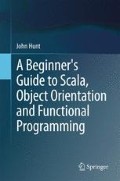Abstract
This chapter takes you through the design of a simple object oriented system without considering implementation issues or the details of any particular language. Instead, this chapter illustrates how to use object orientation concepts to construct a software system. We first describe the application and then consider where to start looking for objects, what the objects should do and how they should do it. We conclude by discussing issues such as class inheritance, and answer questions such as “where is the structure of the program?”.
References
Wirfs-Brock R, McKean A (2002) Object design: roles, responsibilities and collaborations, Addison-Wesley Object Technologiey Series, 0201379430, Nov, 2002
Blaha MR, Rumbaugh JR (2004) Object-Oriented modeling and design with UML (2nd Edition) by Blaha, Michael R., Rumbaugh, James R (2004), Prentice Hall, Prentice Hall (8120330161)
Larman C (2008) Applying UML and patterns: an introduction to object-oriented analysis and design and iterative development, 3rd edn. Dorling Kindersley Pvt Ltd (8177589792, 1 Dec 2008) NJ, USA
Author information
Authors and Affiliations
Corresponding author
Rights and permissions
Copyright information
© 2014 Springer International Publishing Switzerland
About this chapter
Cite this chapter
Hunt, J. (2014). Constructing an Object Oriented System. In: A Beginner's Guide to Scala, Object Orientation and Functional Programming. Springer, Cham. https://doi.org/10.1007/978-3-319-06776-6_4
Download citation
DOI: https://doi.org/10.1007/978-3-319-06776-6_4
Published:
Publisher Name: Springer, Cham
Print ISBN: 978-3-319-06775-9
Online ISBN: 978-3-319-06776-6
eBook Packages: Computer ScienceComputer Science (R0)

